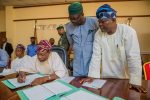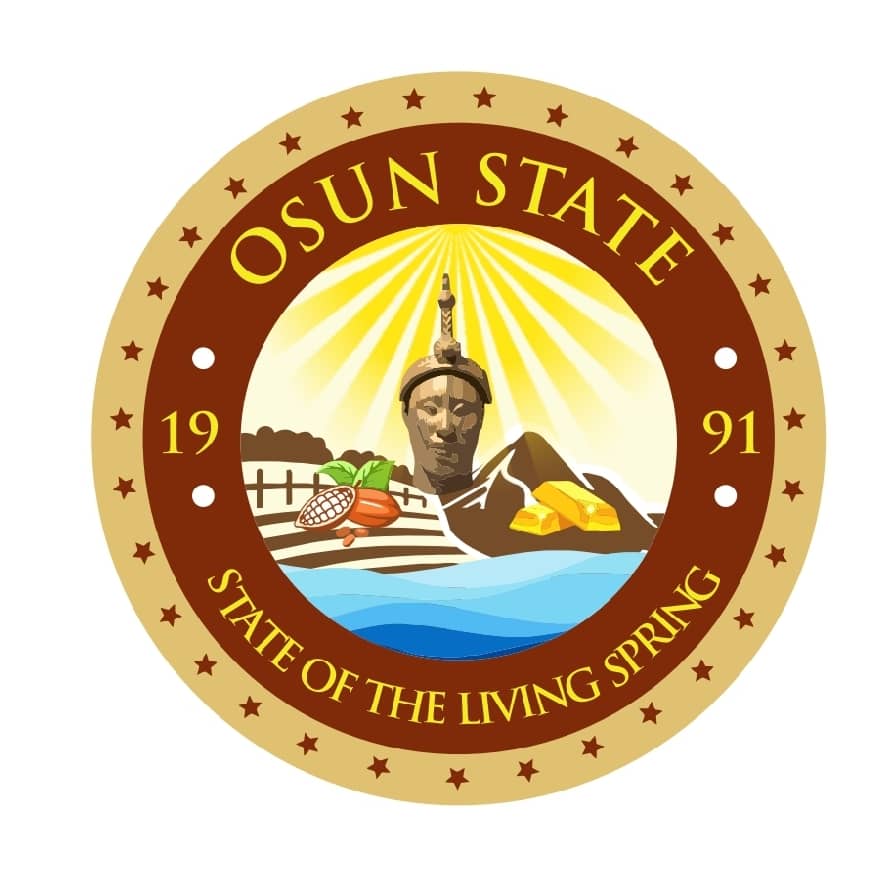Another Kakanfo On The March
By Dare Babarinsa
A few months ago, Otunba Gani Adams informed me that our baba, Kabiyesi Alayeluwa, Oba Lamidi Adeyemi, the Alaafin of Oyo, was going to honour him with the historic title of Are Ona Kakanfo, an office that is surrounded by so many myths and drama. For Adams, this is a singular honour so much different from all the others he has garnered since he emerged on the stage as a significant and controversial presence in the self-determination group. Adams has given meaning to the militant phase of our struggle against military rule and the second phase that is still playing out now in creating a new Commonwealth.
Adams is the national coordinator of the Oodua Peoples Congress, OPC, but apart from this, he is involved in more eclectic enterprises. On the cultural plane, he is the organizer and founder of the yearly Olokun Festival, set up to honour the Yoruba goddess of the sea and wealth. He is of the opinion that politics should not be left to politicians alone. He believes that the Yoruba people of Nigeria should be under only one regional government to maximize their advantage and advance their economic and cultural interests. With the new honour coming from Oyo, Adams now has a pedestal to pursue those interests.
Adams was one of the young people who heeded the call of Dr Frederick Iseotan Fasehun, the founder and President of OPC. Fasehun, Nigeria’s leading anesthesiologist and the enterprising physician had abandoned the stethoscope for the dangerous enterprise of opposing military rule, especially after the infamy of the June 12 annulment. Fasehun reminds one of another physician, Dr. Agostinho Neto, the poet and freedom fighter who became the first President of independent Angola. In 1995, he invited me to his house in Isolo to discuss the nascent Oodua Peoples Congress, OPC and wanted us to collaborate. Most right-thinking Nigerians felt seriously insulted by the criminal annulment of Chief Moshood Abiola’s victory at the June 12, 1993, presidential election. I told Fasehun about Idle Oodua and that though we share similar objectives, it was my colleagues’ advice that the lion and the leopard should hunt in different neighbourhoods. He agreed with us.
Fasehun is one of the bravest men I ever met. In 1996, Chief Anthony Enahoro who was on the hit-list of the Sani Abacha killer squad decided to flee the country. This was after Enahoro’s old friend, the incomparable Osibakoro, Chief Alfred Rewane, was assassinated by suspected agents of the military junta. With the help of a foreign embassy in Lagos, the veteran nationalist and journalist had been in hiding for many weeks while the killer-squad was desperately searching for him. Few days to his departure, Enahoro was brought to the home of our redoubtable leader, Dr. Amos Akingba, a man who fitted that era of danger and daring like he was created for it. It was from the home of Akingba in Ikeja that Fasehun led the team that took Enahoro from Nigeria to the Republic of Benin through the famous NADECO (National Democratic Coalition) route to begin his journey into exile that would ultimately end in the United States.
But Fasehun, who refused to go into exile, was soon caught in the Abacha net when he was arrested in December 1996. He was to remain in the gulag under the most humiliating condition until General Sani Abacha died suddenly in 1998 and General Abdulsalami Abubakar came to power. Abubakar freed Fasehun along with other political prisoners. By the time he returned in 1998, his organisation, the OPC, had become a behemoth. It was easily the most visible of the several self-determination groups and Fasehun towered above other militant leaders like Rotimi Obadofin and Abiodun Kolawole. The metamorphosis was complete, the success was great and so were the troubles. Many of his followers wanted a different kind of organisation from the one that Fasehun ran before he went into detention. The struggle was intense and the contradictions soon led to serious split and bloodletting. Senator Abraham Aderibigbe Adesanya, the leader of Afenifere, the mainstream Yoruba political and cultural movement, was seriously worried about this and tried to find a solution to it. One of the measures taken was the formation of the Coalition of Yoruba Self-Determination Groups, COSEG, bringing in all the militant groups under one umbrella.
Despite the formation of COSEG, the contradictions within the OPC persisted and this led to the permanent schism with the formation of the Gani Adams faction in 1999. With the continuous disruption of peace in the South-West, Chief Olusegun Obasanjo, the new President, ordered the arrest of Adams who was accused of “heinous crimes,” including the assassination of a police officer in Bariga, Lagos. Adams denied the charges, saying, “We are not confrontational.” He added: “We are fighting for self-determination, sovereign national conference and loose federation.”
But he went into hiding and the government put a one million naira price on his head, a lot of money in 2001. President Olusegun Obasanjo gave a marching order to the Inspector-General of Police, Musliu Smith, and the then Lagos State Commissioner of Police, Mike Okiro, that Adams must be captured dead or alive. Okiro, a lawyer, was later to serve with distinction as the Inspector-General of Police.
The situation worried every Yoruba leader. I met with Baba Adesanya in his Apapa, Lagos residence, on his invitation. He was worried about the official clampdown on the OPC and its leadership. He said it would be disastrous if Adams was killed by the police. He said we should get Adams to surrender so that he can have his day in court. He promised that Afenifere would help him with legal representation. I promised that we would take action.
I sent messages to Adams in his hideout through our mutual friends that I would like to see him. Soon his emissaries came to my office at Acme Road, Ogba, and we took off to Adams’ safe house in Agege. We met Adams in an ebullient spirit and in the midst of his people presumably senior members of the OPC. Some youths were holding video recording cameras. I delivered my message and there was immediate uproar. They said no, we will fight. I told them the game is different now and Olusegun Obasanjo was now our elected President. We will fight, but only through the legal and democratic process. Nigeria has shed too much blood. Adams agreed to surrender through his lawyers.
The following day, I met with Okiro at the Police Command Headquarters in Ikeja and told him that Adams has agreed to surrender and that his lawyers would contact the police. I said if he is killed, even by accident, it would be regarded as enemy action by many people. Okiro promised to take appropriate action. Few days later I was with Baba Adesanya again at his Apapa residence to discuss another matter when someone called him on the phone. Adams had been captured. Baba was worried whether he was alright. We later called other people and a police officer confirmed that he was with them but unhurt.
Since then, Adams has transformed from an irascible militant into a sophisticated public figure. He has immersed himself in self-education and has acquired more knowledge about traditional Yoruba politics and modern Nigerian power play. He is an asset in the intractable struggle to re-arrange Nigeria and put the Yoruba people from the River Niger to the Atlantic under one government. This was the expectation of the founding fathers of Nigeria, especially Chief Obafemi Awolowo and his colleagues of the old Action Group, AG. The only obstacle to achieving that goal today is the clan of mostly decadent Yoruba political class who regards the current structure of the Nigerian Commonwealth as a boon for their members.
The Kakanfo is an old Oyo title. However, it has acquired pan-Yoruba significance especially since the Yoruba wars of the 19th Century. Though the Kakanfo is not part of the Iwarefa (the kingmakers) chiefs in Oyo, called the Oyomesi, he is regarded as third in rank and second only to the Basorun. Being the head of the military, he must live outside the capital. That practice is only peculiar to Oyo among the old Yoruba states. In other Yoruba kingdoms, the head of the military, called the Balogun, the Lejua, the Bafon and other titles, was allowed to live in the capital of each kingdom.
In the 19th Century, three kakanfos created the allure of the title and its pan-Yoruba significance. Afonja, who was based in Ilorin, was the Kakanfo who rebelled against his overlord, the Alaafin. His Fulani guests and collaborators later staged a coup against him, got him executed, and seized the rulership of Ilorin till today. His rebellion led to the fall of Oyo and the destruction and subjugation of many Yoruba towns under the trammel of the Fulani. The second was Kurumi, who was based in Ijaiye, helped Atiba to create the present city of Oyo, but who opposed Atiba’s son and successor Alaafin Adelu. Kurumi insisted that Adele must die with his father according to the Constitution of the old country, instead of becoming the Alaafin. Ibadan, the new military power, opposed him. War was inevitable and Ijaiye was defeated. The victorious Ibadan ruler, Oluyole, a descendant of Alaafin Abiodun, felt the title of Kakanfo was inferior and proclaimed himself the Basorun, though the real Basorun was still alive and well in the new Oyo.
The third Kakanfo was Latoosa, the ruler of Ibadan, who violated the ethos of the old Yoruba country which stipulated that every prince who can trace his roots to the Royal House of Oduduwa in Ile-Ife is co-eval with his colleagues and has the right to independence. Catoosa sent his troops to subdue the Ekiti, Ife, Egba, Igbomina and the Ijesha kingdoms and these led to a state of general wars culminating in the 16-year Ekitiparapo War. More than 500,000 soldiers participated in the gory conflict until it stalemated into a bloody daily struggle halted only by the imposition of British colonial rule in the closing years of the 19th Century. Catoosa, who moved his headquarters to the Ibadan war camp in Igbajo, died during the conflict. After that war, the Alaafin refused to confer the title of Kakanfo anymore until Alaafin Bello Gbadegesin Ladigbolu II, gave the title to Chief Ladoke Akintola, then the Premier of the defunct Western Region.
The fear that was expressed when Chief Moshood Abiola took the title in 1988 is still being voiced now that Adams is stepping into his shoes. The belief is that the Kakanfo would not die a peaceful death. However, it is on record that Ojo Aburumaku, who succeeded Kurumi as Kakanfo, died peacefully in his home at Ogbomoso










